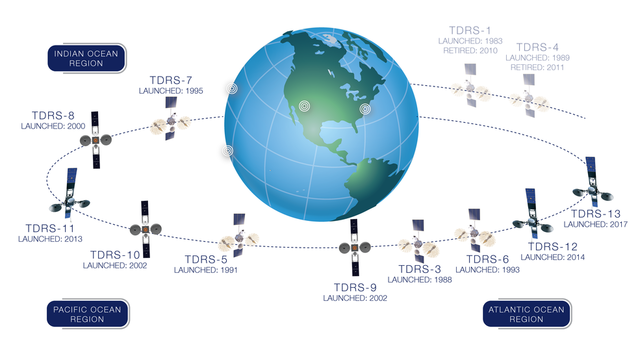Top Qs
Timeline
Chat
Perspective
TDRS-13
American communications satellite From Wikipedia, the free encyclopedia
Remove ads
TDRS-13, known before launch as TDRS-M, is an American communications satellite operated by NASA as part of the Tracking and Data Relay Satellite System. The thirteenth Tracking and Data Relay Satellite, it is the third and final third-generation spacecraft to be launched, following the 2014 launch of TDRS-12.
Remove ads
Spacecraft
TDRS-M was constructed by Boeing, based on the BSS-601HP satellite bus. Fully fueled, it has a mass of 3,454 kg (7,615 lb), with a design life of 15 years.[1] It carries two steerable antennas capable of providing S, Ku and Ka band communications for other spacecraft, with an additional array of S-band transponders for lower-rate communications with five further satellites.[3] The satellite is powered by two solar arrays, which produce 2.8 to 3.2 kilowatts of power, while an R-4D-11-300 engine is present to provide propulsion.[1]
Remove ads
Launch
In 2015, NASA contracted with United Launch Alliance to launch TDRS-M on an Atlas V 401 for $132.4 million. The spacecraft was launched on 18 August 2017 at 12:29 UTC (08:29 local time)[2] from Space Launch Complex-41 at Cape Canaveral Air Force Station.[4]
Damage during final closeouts
On 15 July 2017, The TDRS-M space communications satellite was damaged during the encapsulation process at Astrotech Space Operations.[5]
According to NASA's press release, "NASA and Boeing are reviewing an incident that occurred during final spacecraft closeout activities on the Tracking Data Relay Satellite (TDRS-M) mission at Astrotech Space Operations in Titusville, Florida, on July 14, involving the Omni S-band antenna."[6] This incident did result in a launch delay.[7]


See also
References
Wikiwand - on
Seamless Wikipedia browsing. On steroids.
Remove ads


